|
Running PvP Events
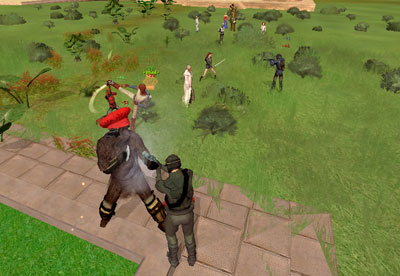
For a large number of players, PvP fighting is the pinnacle of combat in Star Wars Galaxies. Not knowing what your opponent is going to do (or even what stats they may have) lends to the excitement of doing battle. Of course, an added perk is that the sense of victory is greater when you know it's a human on the other end of the screen.
When running PvP events, there is a lot to consider. How many people will be involved? Is it a neutral tournament or GCW battle? What are the rules? What do I need to prepare? What kind of event do I want to run? Below we've listed a number of more advanced ideas and tips to get you started.
Communication - For all events we highly recommend using the global chat channels to keep everyone informed. Not everyone is used to using these, but they can be a HUGE help. For a list of chatroom commands type "/help chatroom". All commands listed begin with /chatroom.
At the very least, event organizers should be on a shared chatroom, and possibly have a moderated chatroom for announcements to all the players. This will help you get information across when things get furious.
To create a chat channel -
1. Right-click on one of your chat tabs (we recommend creating a new blank tab) and choose "Join Chat Channel."
2. Double click on your galaxy.
3. Double click "Chat."
4. Select "Create Channel."
5. Input a Chatroom name and title. The name should be short as you will use / to type into the chatroom. The title is a longer description of the room's purpose.
6. Select "Moderated" if you want to use the room only for announcements. This will allow only moderators to speak.
7. If you select "Private," only those you invite (/chatroom invite will be able to access the room.
8. Click "Done".
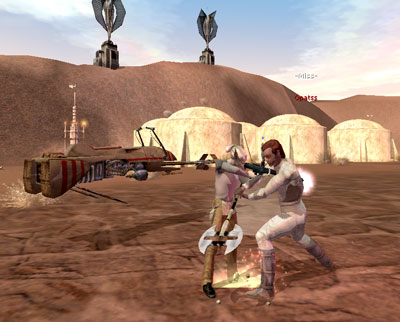
Tournaments
Tournaments are the most common PvP events being run across the galaxies. In these events, entrants are paired off and fight to either incapacitation or, in some of the less civilized parts of the galaxy, death. Generally, tournaments bring in anywhere from ten to thirty entrants.
The first decision to make is what sort of pairings you will have. Will it be One on One? Two vs. two? Sentient being vs. pet? Group vs. group? Each has its own pros and cons, but for the most part all are organized the same way.
The Duel - The most important aspect of PvP tourneys is the "Duel" option. Anytime you want to have non-overt players fight, they will have to use the duel command from the radial menu. Once one player sends a duel request and the other accepts, the fighting can begin. Whoever is incapacitated first can be killed and require cloning, so be sure the combatants know whether the fight is to the death or just to incapacitation.
For events where teams are fighting, each person on team A will have to accept a duel from everyone on team B. It's best to keep this part organized as Duels will run out after five minutes; there isn't a lot of time to waste getting set up. Using the Duel command, you can start to organize tournaments as listed below.
Single Elimination - In this type of tournament, each entrant (single or team) is paired against another. In the first round, everyone fights. The losers are out while the winners proceed to round two. At each fight, someone is eliminated until you have a victor. Nice and simple, this is definitely a "King of the Hill" type of tourney where one mistake means you're out.
If you have an uneven number of entrants, one player gets a "bye." That means they fight no one in that round, and are marked as having a win. In some tournaments, whoever is fighting the "dreaded bye" can have a practice match against a judge or another entrant for fun, but there will be no result. No one should have more than one bye match per tourney.
You can also decide to have a "wild card" slot instead of a bye. To do this you take the players who have been eliminated and assign them a number. Then you roll a chance cube. The winner of the roll gets to re-enter the contest and fight the player who would have otherwise gotten a free win against the bye. Sometimes this second chance can make a big difference in the outcome of the event.
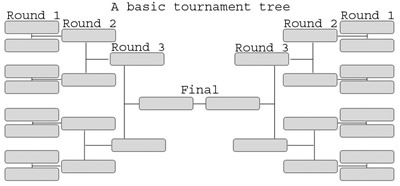
Double Elimination - In this type of tourney, everyone is allowed two losses before they are eliminated. These tourneys require a bit more organization on the part of the event planners, but since everyone is guaranteed two fights, it can draw more people. Two losses also means this type of tourney can run a bit long, so you might want to consider two fighting areas so you can run fights simultaneously.
Once again, every entrant is paired up against another (or the bye) in the first round. Upon finishing their fight, everyone is marked as having won or lost (use your notepad CTRL + N to keep track). Everyone advances to round two. When you move into future rounds, you should pair off entrants who have the same number of losses. From here, anyone who racks up a second loss is out of the tourney. As before, continue until a winner is chosen.
Overt Tourneys -
While PvP tourneys can be run as overt factioned events, there is not much reason beyond possibly roleplaying. Why? Because when you get two or more overts of different factions together, they are not going to wait for a referee to say "go". Someone is going to get shot as soon as they show up. You might not ever get a pair into the ring to fight as they will probably be attacked before they can get there! If you want to keep your tourneys civil, keep everyone covert.
Factioned Events
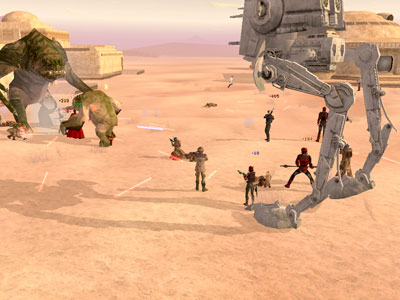
A faction event is for unadulterated combat between two warring parties. Typically the Rebels and Imperials will battle to destroy faction bases, capture territory, or simply to destroy their enemies.
Organizing a faction war is more complicated than it sounds if you want it to run smoothly. A bit of careful planning before the event begins can go a long way towards making a fun and exciting event.
Things to consider - PvP events that involve multiple people fighting simultaneously are easily the most code intensive aspects in a game that already pushes a lot of code back and forth. As with most events, the more people you get in one area, the worse the lag will be for everyone because the server tries to communicate back and forth with personal armor and weapon stats, damage rates, buffs, hits and misses, etc. As your events grow larger, you will need to mitigate these effects.
It's important that as the number of participants increases, you create a way to spread them out. This can be done simply by placing opposing faction bases further apart and by adding multiple bases or objectives. A good rule of thumb is that opposing bases should be placed out of view of one another. With the elimination of the camp/city rule for calling vehicles, spreading out objectives is not much of a hindrance, and can actually add to the tactical experience as cloning can mean a delay in returning to your defenses, a delay that could cost your team the loss of a base. It also makes Doctors and Medics more important if the fighting areas are not near a cloning center.
There have been a number of PvP events that have far exceeded our recommended player limits (50 in one place) simply by having multiple bases per side and keeping them spaced out. The action is still fast and furious, but it is more manageable for both server and client systems to handle. The spacing also makes grouping and organization that much more important while still maintaining the knowledge that the combatants are involved in a large group effort.
In addition to setting up your battlefield properly, you will want to remind players that turning down graphic settings can help with client-side load times and lag. The less information an individual computer needs to process, the better.
If you plan an event where you simply tell the Imperials to attack Point A and the Rebels defend Point A, you will quickly run into many problems. Star Wars Galaxies is a big place. Take advantage of it.
Who to fight - Sounds like an easy question, but the old adage "What if you threw a war and no one showed up?" comes to mind. To have a proper faction PvP event, you need an enemy. This means contacting your counterpart in the enemy faction and planning. You want to make sure the sides are even and that resources such as faction bases and cities and so forth are in place for the event and that cloning facilities are equidistant for each side.
You also need to communicate the goals of the event. Is the goal to simply kill the enemy? Destroy their faction bases? Take over a town? Rescue the POW? Make sure everyone is on the same page. Be sure to have a first and secondary contact for each side in case someone is a no-show on fight day, and utilize the chatrooms as mentioned above to increase communication.
Scenarios - There are a number of "War Game" scenarios that you can use to give structure to your factioned event. Scenarios can be used to add an element of roleplay, to make the event harder or to balance the sides. They can also be used to help spread out forces for when the numbers of fighters exceeds recommended limits. Remember, multiple objectives spread out the players and reduce server load for everyone.
Faction Base takedowns - Faction bases are built and destroyed on a regular basis throughout the galaxy. While this can be done at any time, there is a great thrill when Rebels and Imperials place opposing bases and work to attack and defend at the same time. Having an enemy defend a base will always be more fun than finding a base that is unguarded. This is your straight-forward, knockdown, drag-out, ugly blaster fight to destroy enemy property.
As mentioned before, placement of your bases can be critical to the success of your event. Timing is also important, faction bases are only vulnerable for a short time each day. You need to allow both sides to place their bases near the beginning of the event. Whomever is placing the bases will need an escort as rogue faction members will often kill them, not realizing they have a task to perform.
Rescue the POW - In this scenario one or both the sides have a covert player placed deep in enemy territory, possibly held in a faction base or a public house. The POW is allowed to move only when escorted by a group of overts of either faction. If it is a Rebel POW being led home by friendlies who are then killed, a group of Imperials can lead him back to one of the designated cells, the POW cannot be taken to some out of the way place, they need to be in a pre-designated area, or on their way to a pre-designated area. The winners are the team that can successfully move the POWs to a safe area.
Zone Control - This scenario requires a few impartial judges, and is harder to organize. It tends to work better for smaller groups that are more easily controlled by generals. The goal here is to occupy various Control Points at specific time intervals. To set up, both sides agree on where the control points are. They should be far enough apart that some travel is required to get from one to another. Once the game begins, both sides vie for control. At the specified times, a judge at each site determines who has the most overts controlling the space and awards them one point.
For added fun, a head judge can roll a chance cube at each interval to decide which CP is worth double points. This random factor can add a wild card effect.
This sounds simple, but a lot of strategy is required. Does your side overwhelm one CP to guarantee you take it? It will mean the other side can fortify the other CPs. Do you send an even number to all CPs? Every strategy has its flaws, and the ebb and flow of the game can be very fun.
The Gungan Run - The goal is for one group of overts to make it to a designated area, preferably a PA hall, alive. By marking the PA hall as private, members of that PA, as well as anyone put on the entry list, can enter...as long as they don't have a TEF. The side making the run can travel as a large force, or individually. The opposing force tries to stop as many as they can from reaching the objective. Those who make it inside the PA hall are worth one point. Those who don't make it in by the end of the match award a point to the opposing team. The team with the highest score wins.
The strategy here is centered on TEFs. A player will incur a TEF once they successfully land an attack against an opponent. Once they have a TEF, it will last five minutes before it will wear off and allow them to enter a private structure. If a player has no weapons in hand, he or she will have to be within melee distance to get a TEF. The decision for the player becomes, "Do I make a run for it, or stand and fight and wait out the TEF?" Some players will act as blockers to try to give their other teammates a clear run for the safe zone.
This scenario can be run with both sides trying to reach an objective. Once a faction member reaches the objective, they are tallied, and they can then become blockers.
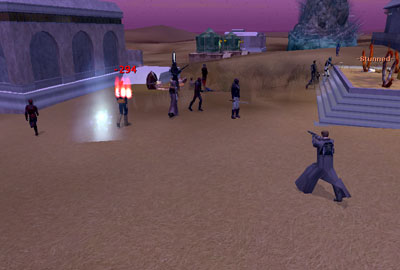
These are just a few suggestions for PvP events. Many more tournaments and factioned scenarios can be implemented. Hopefully the ideas and tips presented here can help you run a successful PvP event.
|
